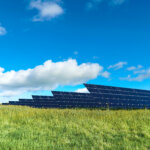November 1, 2024
Understanding Utility-Scale Solar Design and Installation
Utility-scale solar facilities require detailed planning and construction. Here’s an overview of utility-scale solar design and installation.

Solar power generation is increasing rapidly as it has become the most cost-effective energy source driven by growing investments in utility-scale solar projects across the U.S. Utility-scale solar projects are electricity generating facilities with ground mounted photovoltaic (PV) panels capable of powering tens of thousands of homes annually, with no harmful emissions. These solar facilities currently account for 71% of the nation’s solar output, generating enough electricity to power more than 22 million homes.
To continue bolstering the grid and leveraging the many benefits of solar energy, the U.S. needs more utility-scale solar projects in communities across the country. What does installing these facilities entail?
Utility-Scale Solar Design and Installation
Utility-scale solar design and installation involve the following steps:
- Assessment and planning
- Design and optimization
- Site preparation
- Installation and commissioning
Assessment and Planning: Laying the Groundwork
The careful assessment and planning process of a utility-scale solar project can take anywhere from five to 10 years to complete and involves several key components.
Site Selection
Choosing the right location for a solar project is essential. Optimal sites include areas with open land, plenty of sun exposure, and access to transmission infrastructure. Additionally, the soil must be tested to confirm the ground can support solar mounting structures.
Stakeholder Engagement
Arevon engages with key project stakeholders — including the offtaker, permitting agencies, local officials, landowners interested in leasing their land for the project, and the community — to discuss the proposed project, answer questions, and establish a site plan. We take a community-first approach, working closely with local citizens and government officials to ensure each project aligns with their long-term goals.
Environmental and Cultural Studies
Environmental studies are evaluated with a focus on conserving important habitats and species. We collaborate with ecological experts to conduct site-specific environmental studies for each project, ensuring compliance with local and state regulations. Cultural studies are equally crucial to ensure that community values, local history, and protected heritage or cultural sites are respected throughout development and construction.
Permitting
Arevon secures all necessary permits for solar projects in compliance with federal, state, and local regulations. Since the permit requirements can vary by location, we ensure adherence to construction, environmental laws, and safety regulations as well as grid connection and interconnection agreements throughout construction and operations.
Financing and Power Purchase Agreements
Capital expenditures for utility-scale solar projects developed by independent power producers like Arevon are privately funded where debt and equity are raised. Power purchase agreements (PPAs) are vital for financing, offering a stable, low-risk revenue stream. Arevon typically secures long-term PPAs with utility companies and corporate energy buyers for the solar energy produced by its projects before the start of construction.
Design and Optimization: Selecting Equipment for Peak Performance
Arevon finalizes land option agreements and land leases as a more definitive project footprint is established. Then, we begin developing a plan that considers the site’s physical and technical characteristics, including the careful selection of solar panels (also referred to as modules), inverters, and mounting structures to optimize safety, production capacity, and sun exposure. We prioritize made-in-America components to the extent possible.
All solar modules are made from the same basic components, but there are slight material variations that can impact cost and efficiency. Arevon requires that all solar panels pass strict testing protocols established by the U.S. Environmental Protection Agency (EPA) to ensure that even if broken, they do not release hazardous materials into the environment.
Inverters are selected based on number, size, and efficiency for converting direct current (DC) electricity into usable alternating current (AC) electricity. There are a few options for mounting structures including fixed structures, east-west mounts, and tracking mounts. Arevon utilizes flexible tracking mounts, the most effective option, which move panels throughout the day to follow the sun. Finally, some Arevon projects may consider pairing solar with energy storage to store excess solar energy and discharge it when demand is high or solar production is down. This optional addition can greatly increase the efficiency and cost-effectiveness of the facility.
Once the equipment has been selected, detailed design elements are established, including specifics like panel tilt angle and rotation axis, as well as structure spacing to optimize the project and ensure panels can capture as much sunlight as possible.
Site Preparation: Getting Ready for Construction
Preparing the site for construction includes installing stormwater management and erosion control measures and grading the land if needed. Pre-seeding soil and controlling weeds may be necessary at some sites, too. Finally, interior roads are built for construction vehicles and equipment.
Installation and Commissioning: Powering the Grid
Utility-scale solar construction typically takes 12 to 18 months to complete. Arevon works extensively with state and local agencies to ensure maximum safety and minimal disruption to the local community during this time period.
To begin, construction crews drive support posts, known as piles, into the ground, install racking and trackers to the piles, and mount the solar panels to the racking. Then, the crew adds inverters to convert DC energy into AC energy, transformers, and optional energy storage systems, along with a fenced-in substation for primary connection point to the grid.
When construction is complete, the solar facility is ready for commissioning. This involves a thorough site inspection and performance testing to verify the system is operating safely and within specifications. Once it has the green light, the solar project will power the grid for 30 years or more.
Partner With Arevon for Utility-Scale Solar Project Development
With proper planning and execution, utility-scale solar projects create an extensive, homegrown supply of American energy for decades. Arevon is a renewable energy leader with solar, energy storage, and solar-plus-storage projects across the country. Our community-first approach and long-term project ownership ensures maximum social and environmental benefits. Contact us today to start planning your utility-scale solar project.
Do You Have Questions About Utility-Scale Solar Construction? Explore Our FAQs
Back to Insights


